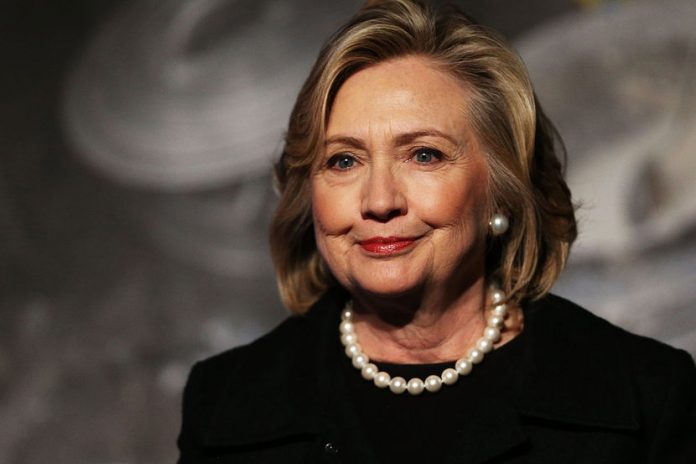Hillary Clinton. That name alone elicits strong reactions from people all over the political spectrum, with universal disgust on the right, enthusiastic support from the center-left, and disappointment from the far left. But by the end of the day, on November 8, 2016, it’ll most likely be her name on the ballot getting tens of millions of votes—and she may very well be our first “Madam President.”
Who is Hillary Clinton?
Hillary Clinton really doesn’t need an introduction, as she is nearly universally known by Americans of all political persuasions, making her the single most well-known individual running for the presidency, announcing her bid this past spring. But that doesn’t mean that people know anything about who she is.
Before marrying Bill, the then-Hillary Diane Rodham grew up in a conservative part of Chicago with an opinionated Republican father who was fervently anti-communist and a quiet, a Democratic mother who cared deeply about social justice, specifically the plight of Japanese-American internment. Interested in politics since her early teens, Hillary volunteered for Republican candidate Barry Goldwater’s campaign in high school after being encouraged by her ninth-grade history teacher to read Goldwater’s book, The Conscience of a Conservative, much to her father’s delight.
After entering Wellesley College in 1965, Hillary found herself in the middle of a group of young, female, activist students; as second-wave feminism began and as the Civil Rights movement hit its stride, her personal politics were transformed. Even though she became president of the Young Republicans in her freshman year, she grew frustrated with Republican policies on civil rights and the Vietnam War, ultimately stepping down from the position after realizing her beliefs were no longer in sync with the Republican Party, going from a Goldwater Girl to a supporter of anti-war Democrat Eugene McCarthy.
A 24-Year Political Career
Her ascent to political stardom began after her husband, Bill Clinton, became governor of Arkansas and eventually president. It was here as the first lady that she began to shine, taking an incredibly active role in her husband’s presidency. Immediately after Bill’s inauguration, she became involved in the fight for health care reform, but conservative opposition defeated the proposal. In 1997, Hillary Clinton pushed for the creation of the State Children’s Health Insurance Program (CHIP), which continues to provide insurance to children caught in the Medicaid gap even today. She then led the charge to correct issues within the foster care system that deterred adoption of children with special needs, persuading a compromise between Republicans and Democrats as talks over the issue broke down, becoming an instrumental player in the passage of the Adoption and Safe Families Act. Her commitment to children has been clear—she spearheaded nationwide immunization programs against childhood illnesses and fought for increased funding for childhood asthma research (as well as prostate cancer research).
As First Lady, she led the charge for gender equality around the world, speaking out against Taliban mistreatment of Afghan women and creating Vital Voices, an organization promoting women economic empowerment and political participation across the globe. Most famously, she declared that “women’s rights are human rights” at the U.N. Fourth World Conference on Women in Beijing and bluntly condemned: sex trafficking of girls, rape as a weapon in war, genital mutilation, the drowning and suffocating of babies born female, forced abortions of female fetuses, and forced sterilization of women. And within the United States, she helped create the Department of Justice’s Office on Violence Against Women.
Near the end of her husband’s second term, she launched a bid for a Senate seat in New York against the likely Republican nominee, New York City mayor, Rudy Giuliani. Giuliani dropped out of the race in the spring of 2000, and Hillary Clinton trounced her new Republican opponent with a 12-point margin, becoming the only first lady to be elected to the Senate. As Senator of New York, she was incredibly popular, winning re-election in 2006 with 67% of the vote, one of the largest margins of victory in New York history. Throughout her one-and-a-half terms in the U.S. Senate (2001–2009), she notably secured $21.4 billion in funding to redevelop the World Trade Center and helped lead investigations of health issues faced by 9/11 responders. She also proved to be a public advocate of health benefits for veterans, working with Republicans (like Senator Lindsay Graham of South Carolina) across the aisle on a law to provide health benefits to members of the National Guard.
In 2007, Hillary Clinton launched a presidential bid but was ultimately defeated after a long, arduous, and close primary battle with then-Senator Barack Obama. After Barack Obama was elected president in a decisive victory for the Democratic Party, she was appointed Secretary of State in 2009, where she helped the United States recover from its tarnished reputation from the heavily criticized foreign policy of the Bush years. Most notably, she pushed for the “pivot” to Asia, characterized by regional engagement in the Asia-Pacific, improving U.S.-China relations, and expanding economic, political, and security cooperation in the region—a move praised by ASEAN (Association of Southeast Asian Nations)11 in the wake of Chinese aggression in territorial disputes with Southeast Asian countries.
And in the spring of 2015, she announced her second bid for the presidency and is currently the Democratic frontrunner, beating her closest opponent Bernie Sanders by an average of 25.5 points in national polling at the time of writing.
“Scandals”
No Hillary Clinton article can be complete without addressing the two major “scandals” swirling around her candidacy. First of all, Benghazi is such a non-scandal, it’s not worth addressing. Multiple House committees have been formed to investigate the attacks on the consulate in Benghazi, and every time the White House has been cleared of wrongdoing. But then there’s the email controversy, which is more of a non-troversy than anything, although it is a murkier one. But here are the key facts:
It’s no secret that as Secretary of State from 2001–2005 under George W. Bush, at the height of tensions in the midst of the Iraq and Afghanistan Wars, Colin Powell also used a personal email. In fact, John Kerry, who was appointed to the position immediately after Hillary Clinton, is the first Secretary of State to use a “standard government email address,” according to the State Department. The Obama administration didn’t have policies against using personal emails until months after Hillary Clinton left the State Department, and the Federal Records Act in effect during Hillary Clinton’s tenure didn’t require government officials to use government email accounts either. There is absolutely zero evidence that she broke a single law by using a private server.
The private server isn’t a new revelation either—Gawker first reported on it in 2013, but it’s largely been ignored until now when Republicans, who have been out to get Hillary Clinton for over two decades, needed something else to try to sink her before November 2016. Even more importantly, the State Department has already explained that the information in the emails she sent were not classified when Hillary sent or received them. And the State Department is notorious for over-classifying information; so there’s no proof that Hillary endangered anyone or anything. So far, neither the Department of Justice nor the FBI have faulted Hillary when it comes to her email server, and there are no investigations against her specifically.
Why Hillary Will Be the Democratic Nominee
Hillary Clinton is facing a tough challenger in the form of Bernie Sanders, the independent Senator of Vermont, known primarily for his outspoken brand of democratic socialism that’s firing up the progressive base on income inequality. But it’s unlikely that Hillary will actually lose the nomination. It’s becoming abundantly clear that Bernie Sanders will win the New Hampshire primary, the first primary of the election, but Bernie still trails Hillary among Democratic caucus-goers in Iowa (the next major nominating election) according to polling models from RealClearPolitics and HuffPost Pollster, although the gap is closing. Even if Bernie Sanders picks up a win in Iowa, he’ll be stopped in his tracks in the South Carolina primary, where Clinton beats Sanders by over a 50-point margin. From there, it’ll be easy for Hillary Clinton to pick up nearly every state in the Deep South, as well as the Southwest and the Rust Belt that she won in 2008—for example, she will beat Sanders (and Biden) by significant margins in Florida, Ohio, and Pennsylvania. It’s not a stretch of the imagination to imagine that she’ll even be able to flip some of Obama’s previous territory in the Midwest and gain more delegates from those states than Bernie Sanders will.
Bernie Sanders’ base is primarily white liberals, particularly white men and those who live in the most liberal enclaves in the country—that means New Hampshire Democrats and even Iowa Democrats are predisposed to like him, but in the southern half of the United States where white Democrats are mostly moderate or conservative (yes, a significant portion of Democratic voters are conservative) and where Latino and/or black voters make up a larger portion of the electorate, Bernie simply can’t win. Hillary Clinton, on the other hand, has created a coalition of black and Latino voters, women, and moderate and conservative Democrats that explains why she’s been polling so well nationally.
If Bernie Sanders can do what Barack Obama did—capture the majority of Southern black voters—then he may have a shot. But it looks like it’ll be a difficult journey for him to make those inroads. And while the populist wave in the Republican Party seems to be sinking Jeb Bush’s campaign (and even Scott Walker’s) in favor of outsiders like Ben Carson and Donald Trump, that populist wave doesn’t seem to be strong enough in the Democratic Party to make Bernie Sanders beat Hillary Clinton.
The Issues
On the issues, Bernie Sanders and Hillary Clinton agree on more issues than they disagree on—especially key Democratic litmus tests like support for reproductive health care and marriage equality and opposition to the Supreme Court’s Citizens United ruling.
Hillary’s exact policy proposals appear to still be in the works (as are most candidates’), but some of her specific proposals so far include economic plans that would include: raising the minimum wage to $12 per hour (slightly lower than Bernie’s $15 per hour proposal), tightening the tax code and closing tax loopholes, passing comprehensive immigration reform to bring our 11 million undocumented immigrants into the economy, creating real economic benefits over the next decade, appointing more regulators to curb risky Wall Street behavior, and giving businesses tax credits for training and hiring workers to promote long-term growth. (Time did an article on her economic proposals that can be found here.)
She also came out with a college-affordability plan that would reduce student loan interest rates and decrease the cost of in-state colleges so that students wouldn’t need to take out loans to afford an education—a $350 billion proposal to be done over a decade ($35 billion a year), a less ambitious plan than Bernie Sanders’ free in-state college plan that would cost $70 billion a year, paid for by closing tax loopholes. She has also called for a shift toward clean energy, defended the validity of climate change (which is real) and vaccine science, and defended the merits of the Affordable Care Act—she has touted her long-time support for affordable health care (stemming from the 1990s) but does not plan to go as far as Bernie’s universal health care plan to expand the single-payer Medicare system to everyone in the country. Most recently she came out with a $10 billion plan to fight drug and alcohol addiction by boosting treatment programs, as well as plans to direct the Attorney General to prioritize treatment over incarceration for nonviolent and low-level drug offenders.






